Definition: Product life cycle can be defined as the analysis of the complete life span of a product. It is divided into five stages, i.e., development, introduction, growth, maturity and decline. It is an essential tool for analyzing the prospective success or potential of a new product through research and development.
Just like humans, a product also has a life cycle which involves multiple stages. However, a product can be saved from declining in the market if necessary steps are taken on time to improvise or replace it.
Content: Product Life Cycle (PLC)
Types of Products
A product is a good or service which can be sold in the market. These products can be classified under the following two categories:
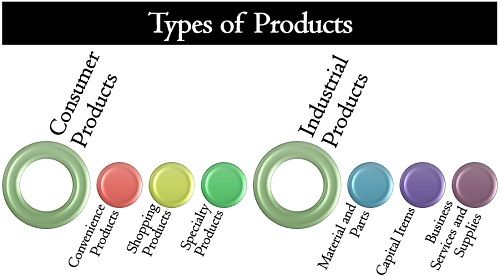
Consumer Products
The goods or services purchased by individuals to meet their personal needs are considered as consumer products. These are primarily of the following three types:
- Convenience Products: The products which are available with ease and fewer efforts and bought in small quantities are known as convenience products. It includes sugar, milk, stationery, newspapers, medicines, etc.
- Shopping Products: Purchase of these products are dependant upon consumer’s choice and preference and requires time and efforts for shopping. Most durable products, such as electronic appliances, furniture, jewellery, etc. are categorized under shopping products.
- Speciality Products: The products which require a lot of efforts to be selected and the demand for these are quite limited and expensive. The examples of speciality products are sculptures, artwork, paintings, etc.
Industrial Products
The goods are services utilized for the production of consumer goods are known as industrial products. These products are divided into the following three types:
- Material and Parts: The raw material and the tools or supporting equipment used for the production of the consumer products are termed under this head. The various items belonging to content and parts are cement, steel, plastic, motor, pump, trolley, etc.
- Capital Items: The fixed assets used for manufacturing, supply and management of consumer goods are defined as capital items. It includes machines, land, plant, building, etc. together with its installation.
- Business Services and Supplies: These products are the secondary goods or services which support the manufacturing activities. The services include advertisement, transportation, legal services, etc. and supplies consist of office supplies such as pen, files, papers; whereas maintenance supplies like paint, lubricants, brooms, etc.
Product Life Cycle Stages
The product life cycle includes five stages defining the journey of a product in the market. Let us now discuss each step of the product’s life in details below:
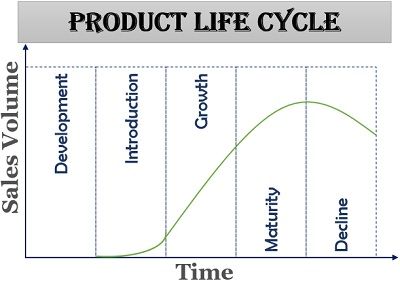
Development Stage
The first stage of the product life cycle is the development stage at which the new product generates. Here, the company needs to pay off various cost involved in product research, manufacturing or acquisition without generating any revenue from it. The features of this stage are as follows:
- Generation of a workable product idea
- Making investment
- No sales revenue
Introduction Stage
At this stage, the new product is launched in the market, and the prospective customers are acquainted with it. The demand for the product is created at this stage. The characteristics of the introduction stage are as follows:
- Creation of the product’s demand
- No or low-profit stage
- May encounter brand issues
- Low sales volume
- Promotion and free samples
Growth Stage
The third stage of the product life cycle is the growth stage where the product sales, demand and profits accelerate. It consists of the following characteristics:
- Sales increases rapidly
- Constant price
- Market segment penetration
- High marketing and promotional expenses
- Manufacturing cost decreases
- High-profit margin
Maturity Stage
The sales of the product are at its peak and price is competitive at the maturity stage. The features of this stage are as follows:
- Low cost due to high production volume
- Industrial profits decline
- High competition
- Optimum sales volume
- Market saturation
- The entry of new competitors
- Requires brand differentiation or feature diversification to sustain in the market
Decline Stage
This is the last stage of the product where the demand shrinks and its sales start declining. The features of the decline stage are mentioned below:
- Sales volume decreases gradually
- Product price falls
- Low margin
- Implementation of new strategies
- Introduction of a new product
Advantages of the Product Life Cycle
A product life cycle is extensively used by the organizations to understand and estimate the performance of a product in the market. The company can benefit in the followings ways from a product life cycle:
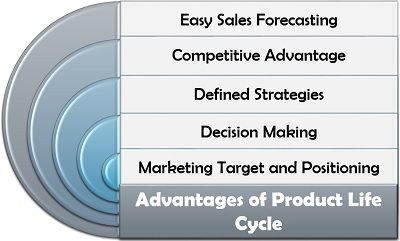
- Easy Sales Forecasting: The product life cycle is an estimation of the sales which the product will be able to make in its life span.
- Competitive Advantage: Analyzing the life of a product in the market and framing the strategies accordingly, helps the company to face competition.
- Defined Strategies: If the company is aware of the product’s future performance, the company can determine and plan the strategies in the long run.
- Decision Making: To make crucial decisions related to the product such as product development or improvement, product life cycle analysis is essential.
- Marketing Target and Positioning: Product life cycle provides for targeting the right audience and establishing the brand image of the product.
Disadvantages of the Product Life Cycle
The product life cycle is a mere forecast and depends upon the prospective sales estimate. It has various other limitations which are as follows:
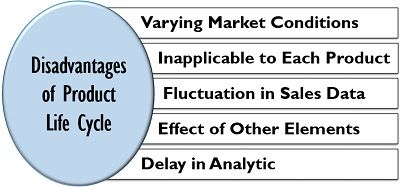
- Varying Market Conditions: The market conditions vary from place to place, and the same product life cycle may not be suitable for every market.
- Inapplicable to Every Product: Some services like mobile network and computer software, keep on frequently updating from time to time. However, it does not mean that the brand gets obsolete.
- Fluctuation in Sales Data: Variation in the sales data is essential for the product life cycle. But it is difficult for the company to predict such information to plot the PLC curve.
- Effect of Other Elements: The analysis of the product life cycle is also affected by the various elements of the 4 Ps of the marketing mix, including the product itself, price, place and promotion.
- Delay in Analytics: The product life cycle requires collection and analysis of the sales data, which is delayed or unavailable at times.
Product Life Cycle Management
The management has to concentrate on various business areas or fields to make the product a success. Following are the specialized management fields which need to be taken care of right from the launch of the product to its decline in the market:
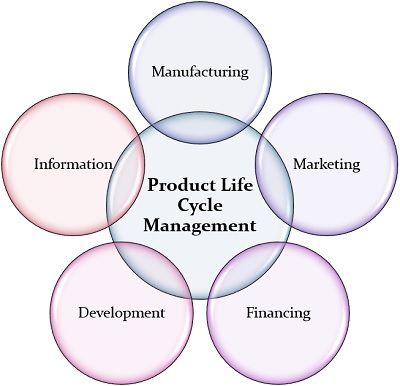
Manufacturing: The cost of production of goods and services matter and vary to a great extent during a product’s life cycle. This cost very high at the development stage whereas it gradually decreases at the growth and maturity stages.
Marketing: The strategy for marketing the product varies at each stage. When the introduction stage requires excessive marketing and promotion, unlike the growth stage where the product requires less publicity and is popular among customers, this strategy changes entirely at the decline stage.
Financing: The initial capital requirement at the introduction stage of a product is quite high. Whereas, at the growth and maturity stage, the product self finances itself through sales and profit earned by it.
Development: At the development stage of a product, the management needs to focus on research and analysis. It invests maximum time, energy and efforts in the development of a new product.
Information: The collection and analysis of potential data, including market trends, effective means of promotion, prospective growth, etc. are necessary for the management.
Conclusion
The product life cycle planning and analysis is an integrated function of all the departments of the organization. Also, it is an ongoing process which never ends.
BETSHEBA KANGWA says
The product life planning is very perfect for people under marketing.